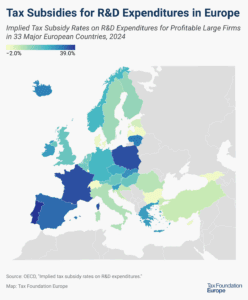
Analyzing Recent Tax Trends Among EU Countries
7 min readBy:In recent years, EU countries have undertaken a series of taxA tax is a mandatory payment or charge collected by local, state, and national governments from individuals or businesses to cover the costs of general government services, goods, and activities. reforms designed to maintain tax revenue levels while supporting investment and economic growth. In general, tax reforms focused on reducing individual and corporate income taxA corporate income tax (CIT) is levied by federal and state governments on business profits. Many companies are not subject to the CIT because they are taxed as pass-through businesses, with income reportable under the individual income tax. rates while increasing environmental or wealth taxes. However, as summarized here, not all tax reforms were created equal. Poorly designed fiscal policy and tax hikes might undermine the economic recovery.
The European Commission has recently released the fiscal policy guidance for 2023 as EU countries are recovering from the economic impact of the pandemic. The 2022 winter Commission forecast (done before Russia’s invasion of Ukraine) projected 4 percent Gross Domestic Product (GDP) growth for the EU member states in 2022 and 2.8 percent GDP growth for 2023. With these economic predictions, the European Commission recommends low-debt countries to focus more on investment for the green and digital transition, while high-debt countries should focus on reaching budgetary stability and debt reduction.
Individual Tax Reforms in the EU
Austria’s 2022 budget reduced from 35 percent to 30 percent the personal income tax rate for the second tax bracket as of July 2022. In 2021, the personal income tax rate on the first tax bracket was also lowered, from 25 percent to 20 percent. However, another reduction from 42 percent to 40 percent for the third income tax bracket was pushed back one year to mid-2023.
In 2021, the Czech Republic reintroduced progressive income taxation with two tax bracketsA tax bracket is the range of incomes taxed at given rates, which typically differ depending on filing status. In a progressive individual or corporate income tax system, rates rise as income increases. There are seven federal individual income tax brackets; the federal corporate income tax system is flat. and a top rate of 23 percent on income beyond CZK 1 million (US $44,679); that amount that was raised to CZK 1.8 million ($80,421) in 2022. Previously, a 15 percent flat tax was applied.
Greece suspended the solidarity surcharge in 2020. However, in 2022, the surcharge is suspended only for workers in the private sector.
Latvia cut the top tax rate from 31.4 percent to 31 percent in 2021. The top rate applies to income above EUR 78,100 ($86,129).
In 2021, Norway reduced the income tax rate by 0.2 percentage points for the first and second tax brackets. In 2022, it increased the income tax rate by 0.2 percentage points for the third and fourth tax brackets and a fifth tax bracket was added for incomes over NOK 2 million ($2.28 million) that are subject to a marginal tax rateThe marginal tax rate is the amount of additional tax paid for every additional dollar earned as income. The average tax rate is the total tax paid divided by total income earned. A 10 percent marginal tax rate means that 10 cents of every next dollar earned would be taken as tax. of 17.4 percent on top of the 22 percent flat taxAn income tax is referred to as a “flat tax” when all taxable income is subject to the same tax rate, regardless of income level or assets. . Therefore, in 2022, the top income tax rate has increased from 38.2 to 39.4 percent. Additionally, Norway continued to adjust the income tax brackets for inflation.
Norway also raised the adjustment factor applied to gains on shares and dividends from 1.44 percent to 1.6 percent in 2022, raising the effective capital gains taxA capital gains tax is levied on the profit made from selling an asset and is often in addition to corporate income taxes, frequently resulting in double taxation. These taxes create a bias against saving, leading to a lower level of national income by encouraging present consumption over investment. rate from 31.7 percent up to 35.2 percent.
Poland approved a tax reform plan, the so-called “Polish Deal,” in 2022. The reform increased the income tax threshold from PLN 8,000 ($1,885) to PLN 30,000 ($7,074) while the health insurance contribution is no longer tax-deductible from the personal income. Instead, tax relief is offered to taxpayers with annual earnings between PLN 68,410 ($16,132) and PLN 133,692 ($31,527).
In 2021, Spain raised income tax by 2 percentage points for those with an annual income greater than EUR 300,000 ($331,485). This pushed the top statutory tax rate to 54 percent in Valencia Community. The last time Spain’s central government adjusted the individual income tax brackets for inflationInflation is when the general price of goods and services increases across the economy, reducing the purchasing power of a currency and the value of certain assets. The same paycheck covers less goods, services, and bills. It is sometimes referred to as a “hidden tax,” as it leaves taxpayers less well-off due to higher costs and “bracket creep,” while increasing the government’s spending power. was in 2008.
Additionally, the tax on capital gains above EUR 200,000 ($220,566) was increased by 3 percentage points to 26 percent.
Business Tax Reforms in the EU
In 2024, Austria will cut the corporate income tax from 25 percent to 23 percent. The government is also considering raising the tax exemptionA tax exemption excludes certain income, revenue, or even taxpayers from tax altogether. For example, nonprofits that fulfill certain requirements are granted tax-exempt status by the Internal Revenue Service (IRS), preventing them from having to pay income tax. threshold on profits up to EUR 30,000 ($33,085) from 13 percent to 15 percent.
France lowered the standard statutory corporate income tax rate in 2022 to the current 25.83 percent (including the 3.3 percent social surcharge).
The Netherlands discarded the originally planned reduction of the corporate tax rate to 21.7 percent and, in exchange, the statutory corporate income tax rate has been increased to 25.8 percent in 2022. However, at the same time, the higher tax bracket was increased from EUR 245,000 ($270,193) in 2021 to EUR 345,000 ($380,476) in 2022.
Poland, trying to emulate Estonia, adopted a new tax rule in 2021 that allows businesses with revenues below PLN 100 million ($24 million) to only be taxed on their income when it is distributed to shareholders. Limiting the reform only to businesses below the revenue threshold could drive some businesses to misreport revenues to stay below the threshold. In 2022, the “Polish Deal,” a tax system overhaul, came into effect. Many measures focus on tax relief for Research and Development (R&D), such as the simultaneous application of the R&D and patent box’s tax relief or a 200 percent deduction for certain R&D expenditures. Additionally, a minimum 10 percent corporate income tax has been approved, applied when a company’s net income represents less than 1 percent of the total revenue, excluding capital gains.
Spain approved a new minimum corporate tax rate of 15 percent for 2022, applied to large companies with annual revenue over €20 million (US $22 million), while banks and energy firms must pay a minimum of 18 percent. Large multinational businesses headquartered in Spain will also face higher taxes as in 2021 the government reduced tax exemptions from 100 percent to 95 percent for dividends and capital gains from overseas subsidiaries.
In 2021, Sweden cut the corporate income tax from 21.4 percent to the current 20.6 percent.
Wealth TaxA wealth tax is imposed on an individual’s net wealth, or the market value of their total owned assets minus liabilities. A wealth tax can be narrowly or widely defined, and depending on the definition of wealth, the base for a wealth tax can vary. Reform in the EU
Norway and Spain are among the few countries in the world that still have a levy on net wealth. In 2021, Spain modified the wealth tax which is collected and administered by the regional governments. The wealth tax rate on wealth above EUR 10.7 million ($11.8 million)—the top wealth bracket—was increased by 1 percentage point from 2.5 percent to 3.5 percent. In 2022, Norway increased the net wealth tax rate from 0.85 percent to 0.95 percent for net wealth exceeding NOK 1.7 million ($0.19 million); it was NOK 1.5 million ($0.17 million) in 2021. Additionally, for net wealth exceeding NOK 20 million ($2.3 million), the tax rate is 1.1 percent.
These wealth tax reforms have the potential to exacerbate the distortions created by this tax. Given that wealth taxes collect little revenue and have the potential to disincentivize entrepreneurship, harming innovation and impacting long-term growth, perhaps Spain and Norway should repeal the tax altogether.
Environmental Tax Reforms in the EU
In the case of Austria, to compensate for the income and corporate tax reliefs and to comply with the European Union’s green transition agenda, Austria will start to tax CO2 emissions at EUR 30 ($33) per ton from July 2022, and gradually increase it to EUR 55 ($61) per ton by 2025. The government is also looking into a series of measures to offset the additional burden on taxpayers caused by carbon pricing, including an investment allowance of up to EUR 350 million ($385 million) to improve businesses’ energy efficiency and help them become more environmentally friendly.
Norway’s 2022 budget proposal was set to increase taxes on CO2 emissions that are not part of the European Union Emissions Trading System by 28 percent to NOK 2,000 ($228.53) per metric ton in 2030. However, in 2022, the CO2 emission tax on diesel and heating oil was already increased by almost 30 percent and set to NOK 2,005 ($229.11) per metric ton, above the 2030 target. To offset the additional burden on taxpayers caused by carbon pricing, the government proposed a general travel deduction of NOK 1.65 ($0.19) per kilometer. Nevertheless, in 2021, after discounting credits and subsidies, oil and gas taxA gas tax is commonly used to describe the variety of taxes levied on gasoline at both the federal and state levels, to provide funds for highway repair and maintenance, as well as for other government infrastructure projects. These taxes are levied in a few ways, including per-gallon excise taxes, excise taxes imposed on wholesalers, and general sales taxes that apply to the purchase of gasoline. revenue almost tripled compared to 2020, due to high gas prices in the second half of the year.
EU Tax Reforms for Economic Growth
Reducing personal income tax has the potential to increase disposable income for workers, raise consumption, and potentially contribute to economic growth. Additionally, individual income taxAn individual income tax (or personal income tax) is levied on the wages, salaries, investments, or other forms of income an individual or household earns. The U.S. imposes a progressive income tax where rates increase with income. The Federal Income Tax was established in 1913 with the ratification of the 16th Amendment. Though barely 100 years old, individual income taxes are the largest source of tax revenue in the U.S. parameters need to be indexed for inflation. Otherwise, higher levels of inflation can artificially increase individual tax burdens. The delay in implementing these tax cuts will postpone growth and labor market impacts intended to be achieved with these tax reforms.
While transitioning from income taxation to carbon taxation might have a positive impact on employment, relying too heavily on carbon taxation at a time when energy and fuel costs are at one of their highest levels might undermine economic recovery.
Instead, countries could consider full expensing to increase private investment and move towards a permanent and neutral corporate tax. As governments are moving towards budgetary stability, policymakers should focus on consumption taxes and make them more efficient and neutral by broadening the tax base, lowering the tax rate, and eliminating unnecessary tax exemptions. Countries might also want to put in place compensation measures for poorer households.
Policymakers should work to ensure that their tax systems are geared towards investment, jobs, and economic growth for the long term.
See Updated Research & Analysis
Share this article




